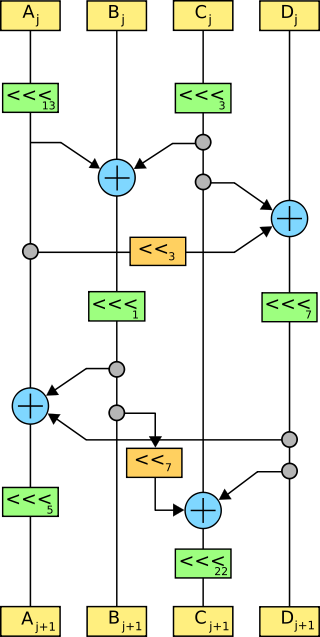Related Research Articles

The Advanced Encryption Standard (AES), also known by its original name Rijndael, is a specification for the encryption of electronic data established by the U.S. National Institute of Standards and Technology (NIST) in 2001.
In cryptography, a block cipher is a deterministic algorithm operating on fixed-length groups of bits, called blocks. Block ciphers are specified elementary components in the design of many cryptographic protocols and are widely used to encrypt large amounts of data, including in data exchange protocols. A block cipher uses blocks as an unvarying transformation.
Differential cryptanalysis is a general form of cryptanalysis applicable primarily to block ciphers, but also to stream ciphers and cryptographic hash functions. In the broadest sense, it is the study of how differences in information input can affect the resultant difference at the output. In the case of a block cipher, it refers to a set of techniques for tracing differences through the network of transformation, discovering where the cipher exhibits non-random behavior, and exploiting such properties to recover the secret key.
Symmetric-key algorithms are algorithms for cryptography that use the same cryptographic keys for both the encryption of plaintext and the decryption of ciphertext. The keys may be identical, or there may be a simple transformation to go between the two keys. The keys, in practice, represent a shared secret between two or more parties that can be used to maintain a private information link. The requirement that both parties have access to the secret key is one of the main drawbacks of symmetric-key encryption, in comparison to public-key encryption. However, symmetric-key encryption algorithms are usually better for bulk encryption. They have a smaller key size, which means less storage space and faster transmission. Due to this, asymmetric-key encryption is often used to exchange the secret key for symmetric-key encryption.
In cryptography, Lucifer was the name given to several of the earliest civilian block ciphers, developed by Horst Feistel and his colleagues at IBM. Lucifer was a direct precursor to the Data Encryption Standard. One version, alternatively named DTD-1, saw commercial use in the 1970s for electronic banking.

Serpent is a symmetric key block cipher that was a finalist in the Advanced Encryption Standard (AES) contest, where it was ranked second to Rijndael. Serpent was designed by Ross Anderson, Eli Biham, and Lars Knudsen.
In cryptography, Camellia is a symmetric key block cipher with a block size of 128 bits and key sizes of 128, 192 and 256 bits. It was jointly developed by Mitsubishi Electric and NTT of Japan. The cipher has been approved for use by the ISO/IEC, the European Union's NESSIE project and the Japanese CRYPTREC project. The cipher has security levels and processing abilities comparable to the Advanced Encryption Standard.

In cryptography, LOKI97 is a block cipher which was a candidate in the Advanced Encryption Standard competition. It is a member of the LOKI family of ciphers, with earlier instances being LOKI89 and LOKI91. LOKI97 was designed by Lawrie Brown, assisted by Jennifer Seberry and Josef Pieprzyk.
In cryptography, SHARK is a block cipher identified as one of the predecessors of Rijndael.

In cryptography, DEAL is a symmetric block cipher derived from the Data Encryption Standard (DES). The design was proposed in a report by Lars Knudsen in 1998, and was submitted to the AES contest by Richard Outerbridge.
The Scream cipher is a word-based stream cipher developed by Shai Halevi, Don Coppersmith and Charanjit Jutla from IBM.

ShangMi 4 (SM4) is a block cipher used in the Chinese National Standard for Wireless LAN WAPI and also used with Transport Layer Security.
In cryptography, CRYPTON is a symmetric block cipher submitted as a candidate for the Advanced Encryption Standard (AES). It is very efficient in hardware implementations and was designed by Chae Hoon Lim of Future Systems Inc.
In cryptography, Mercy is a tweakable block cipher designed by Paul Crowley for disk encryption.
In cryptography, DFC is a symmetric block cipher which was created in 1998 by a group of researchers from École Normale Supérieure, CNRS, and France Télécom and submitted to the AES competition.
In cryptography, Hierocrypt-L1 and Hierocrypt-3 are block ciphers created by Toshiba in 2000. They were submitted to the NESSIE project, but were not selected. Both algorithms were among the cryptographic techniques recommended for Japanese government use by CRYPTREC in 2003, however, both have been dropped to "candidate" by CRYPTREC revision in 2013.
In cryptography, ARIA is a block cipher designed in 2003 by a large group of South Korean researchers. In 2004, the Korean Agency for Technology and Standards selected it as a standard cryptographic technique.
The following outline is provided as an overview of and topical guide to cryptography:

In cryptography, Twofish is a symmetric key block cipher with a block size of 128 bits and key sizes up to 256 bits. It was one of the five finalists of the Advanced Encryption Standard contest, but it was not selected for standardization. Twofish is related to the earlier block cipher Blowfish.

Speck is a family of lightweight block ciphers publicly released by the National Security Agency (NSA) in June 2013. Speck has been optimized for performance in software implementations, while its sister algorithm, Simon, has been optimized for hardware implementations. Speck is an add–rotate–xor (ARX) cipher.
References
- M. Matsui, T. Tokita (March 1999). Cryptanalysis of a Reduced Version of the Block Cipher E2 (PDF). 6th International Workshop on Fast Software Encryption (FSE 1999). Rome: Springer-Verlag. pp. 71–80. doi:10.1007/3-540-48519-8_6 . Retrieved 27 February 2007.